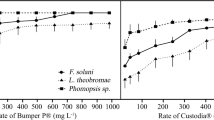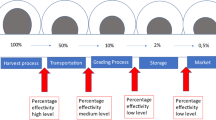Abstract
Kiwifruit is a very important crop for the Greek agricultural industry. Postharvest diseases are the cause of the most important problems of the kiwifruit. This paper considers some general aspects of the various postharvest diseases of kiwifruit in Greece. One of the main aims of this study was the investigation of the pathogens causing postharvest fruit rots in kiwifruit in Greece. The results showed that the fungus Botrytis cinerea was responsible for 100% of the postharvest fruit rots in the regions of Skydra Pella and Vrodou Katerini. This fungus was also responsible for the postharvest fruit rots at a level of 85% in the region of Chrysoupoli Kavala. The fungus Penicillium expansum was also responsible for about 12% in the region of Chrysoupoli Kavala, while the fungi Alternaria sp. and Diaporthe sp. were responsible for about 1–3% of infections. Overripe and softened kiwifruits incubated in room temperatures (about 20–23 °C) for 3 days, after 5 months cold storage, were infected with the fungus Rhizopus stolonifer. In addition, the effectiveness of the fungicides fludioxonil, fludioxonil+cyprodinil and boscalid+pyraclostrobin, applied as postharvest fruit dipping, was evaluated. None of the above fungicides has been registered for use on harvested kiwifruit in Greece although fludioxonil has been registered for postharvest applications in peach and nectarines. The results showed that all fungicides were effective against B. cinerea and P. expansum. Finally, the levels of residues of the fungicides tested in the kiwifruit were investigated about five months after their application. The results showed that only the level of residues of fludioxonil and boscalid were below of the Maximum Residue Levels (MRLs). In contrast, the residues of the cyprodinil, and pyraclostrobin were above of MRLs.
Similar content being viewed by others
References
Adaskaveg JE, Forster H, Gubler WD, Teviotdale LB, Thompson DF (2005) Reduced-risk fungicides help manage brown rot and other fungal disease of stone fruit. Calif Agric 52:109–114
Barnett HL, Hunter BB, (1998) Illustrated Genera of Imperfect Fungi (paperback), 4th edition, APS press, 3340 Pilot Knob Rd., Saint Paul, MN, United States
Boukouvalas S, Chouliaras V (2005) Factors affecting storage life in kiwifruit. AgroThesis 3:26–32
Brigati S, Donati I, Mari IM, Neri F, Gregori R (2010) Physical and chemical systems for the control of Botrytis cinerea rot in kiwifruit and removal of the chemical residues from the fruit. Acta Hortic (877):1647–1652
Bryk H (1991) Laboratory evaluation of the sensitivity of some post harvest apple pathogens to several fungicides. Fruit Science Report 18:97–102
Errampalli D (2004) Effect of fludioxonil on germination and growth of Penicillium expansum and decay in apple cvs. Empire and gala. Crop Prot 23:811–817
Errampalli D, Crnko N (2004) Control of blue mold caused by Penicillium expansum on apples 'Empire' with fludioxonil and cyprodinil. Canandian Journal of Plant Patholology 26:70–75
Godwin JR, Anthony VM, Clough JM (1992) ICIA5504: A Novel, Broad Spectrum, Systemic β-methoxyacrylate Fungicide, British Crop Protection Council, Farnham, UK, pp. 435–442
Kaan Selvi A, Delen N, Gencer R, Kinay Teksür P (2016) Sensitivity against some fungicides and molecular characterization of Botrytis cinerea isolates on grapes in Aegean region. Acta Hortic 1144:279–286
Kim JO, Shin JH, Gumilang A, Chung K, Choi KY, Kim SK (2016) Effectiveness of different classes of fungicides on Botrytis cinerea causing gray mold on fruit and vegetables. Plant Pathol J 32:570–574
Lolas-Caneo M, Diaz GA, Mendez R, Caceres M, Neubauer L (2016) Evaluation of the efficacy of fungicide fludioxonil in the postharvest control of bull’s eye rot (Neofabraea alba) in Chile. Acta Hortic 1144:461–464. https://doi.org/10.17660/ActaHortic.2016.1144.68
Li L, Pan H, Chen M, Zhang S, Zhong C (2017) Isolation and identification of pathogenic fungi causing postharvest fruit rot of kiwifruit (Actinidia chinensis) in China. J Phytopathol 165:782–790. https://doi.org/10.1111/jph.12618
Liu S, Hai F, Jiang J (2017) Sensitivity to Fludioxonil of Botrytis cinerea isolates from tomato in Henan Province of China and characterizations of Fludioxonil-resistant mutants. J Phytopathol 165:98–104
Michailides T, Elmer P (2000) Botrytis gray mold of kiwifruit caused by Botrytis cinerea in the United States and New Zealand. Plant Dis 84:208–223
Mouden N, Ghliyeh M, Benkirane R, Quazzani-Touhami A, Douira A (2016) Chemical control of some fungal strawberries fungal pathogens by foliar fungicides under in vitro and in vivo conditions. International Journal of Recent Science and Research 7:9037–9051
Pennycook SR (1989) Practical solution for botrytis control. New Zealand Kiwifruit 55:9
Petit AN, Vaillant-Gaveau N, Walker AS, Leroux P, Bailieul F, Panon ML, Clement C, Fontaine F (2011) Effects of fludioxonil on Botrytis cinerea and on grapevine defense response. Phytopathol Mediterr 50:130–138
Pyke NB, Manktelow DG, Elmer PAG, Tate KG (1994) Postharvest dipping of kiwifruit in iprodione to control stem-end rot caused by Botrytis cinerea. N Z J Crop Hortic Sci 22:81–86
Rotemv J (1994) The Genus Alternaria: Biology, Epidemiology, and Pathogenicity. APS Press, 3340 Pilot Knob Rd., Saint Paul, MN, United States
Sallato BV, Torres R, Zoffoli JP, Latorre BA (2007) Effect of boscalid on postharvest decay of strawberry caused by Botrytis cinerea and Rhizopus stolonifer. Span J Agric Res 5:67–78
Serey RA, Torres R, Latorre AB (2007) Pre- and post-infection activity of new fungicides against Botrytis cinérea and other fungi causing decay of table grapes. Ciencia e Investigación Agraria 34:215–224
Taheri H, Ershad J, Fifaii R (2009) Identification of fungus agents that cause kiwifruit rots in cool storages. Pajouhesh-va-Sazandegi 21:34–39
Xiao CL, Boal RJ (2009) Residual activity of fludioxonil and pyrimethanil against Penicillium expansum on apple fruit. Plant Dis 93:1003–1008
Author information
Authors and Affiliations
Corresponding author
Rights and permissions
About this article
Cite this article
Thomidis, T., Prodromou, I. Evaluation of the effectiveness of three fungicides against pathogens causing postharvest fruit rot of kiwifruit. Australasian Plant Pathol. 47, 485–489 (2018). https://doi.org/10.1007/s13313-018-0591-7
Received:
Accepted:
Published:
Issue Date:
DOI: https://doi.org/10.1007/s13313-018-0591-7




